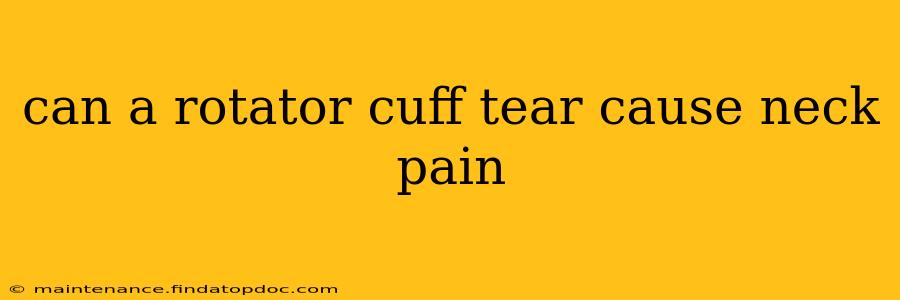A rotator cuff tear, while primarily affecting the shoulder, can indeed cause referred pain in the neck. This isn't always the case, and the pain's location and intensity vary depending on the severity and location of the tear, as well as individual anatomical differences. Let's explore this connection in detail.
How Can a Rotator Cuff Tear Lead to Neck Pain?
The intricate network of nerves and muscles connecting the shoulder and neck plays a crucial role. Pain originating from the shoulder can easily radiate to the neck due to shared nerve pathways and the interconnectedness of the muscles. When the rotator cuff is damaged, the resulting inflammation and muscle spasms can affect nearby structures, including the neck muscles. This can lead to pain, stiffness, and discomfort in the neck region.
Think of it like a chain reaction: The initial injury in the shoulder disrupts the normal biomechanics of the entire upper body. The body compensates by altering posture and muscle tension, which often manifests as neck pain.
What Other Symptoms Might Accompany Neck Pain from a Rotator Cuff Tear?
While neck pain can be a symptom, it's rarely the only one. A rotator cuff tear typically presents with a combination of symptoms, including:
- Shoulder pain: This is usually the most prominent symptom, often localized to the side or front of the shoulder.
- Weakness: Difficulty lifting or rotating the arm.
- Limited range of motion: Inability to fully raise, lower, or rotate the arm.
- Clicking or popping sound in the shoulder: This occurs when the damaged tendons rub against the bone.
- Swelling: Inflammation around the shoulder joint.
Can Neck Pain Be the Only Symptom of a Rotator Cuff Tear?
While less common, it's possible to experience neck pain as the predominant symptom of a rotator cuff tear, especially in cases of smaller tears or tears located in specific areas of the rotator cuff. The body's complex compensatory mechanisms can sometimes mask the primary shoulder pain, making neck pain the most noticeable symptom.
How is Neck Pain from a Rotator Cuff Tear Diagnosed?
A thorough physical examination is crucial. Your doctor will assess your range of motion, strength, and palpate the affected area for tenderness and muscle spasms. Imaging techniques, such as X-rays, MRIs, and ultrasound, can provide a more detailed picture of the rotator cuff and rule out other possible causes of neck pain.
How is Neck Pain from a Rotator Cuff Tear Treated?
Treatment approaches vary depending on the severity of the tear. Options may include:
- Conservative management: This includes rest, ice, physical therapy, pain relievers, and anti-inflammatory medications.
- Surgery: In cases of significant tears or if conservative management fails, surgical repair may be necessary.
Does a Rotator Cuff Tear Always Cause Neck Pain?
No, a rotator cuff tear does not always cause neck pain. Many individuals with rotator cuff tears experience shoulder pain without neck involvement. The presence or absence of neck pain depends on various factors, including the size and location of the tear, individual anatomy, and the body's compensatory mechanisms.
What other conditions can cause both neck and shoulder pain?
Several conditions can cause pain in both the neck and shoulder. These include:
- Cervical radiculopathy: A pinched nerve in the neck.
- Thoracic outlet syndrome: Compression of nerves and blood vessels in the space between your collarbone and your first rib.
- Spondylosis: Degenerative changes in the spine.
- Referred pain from other areas: Pain originating from internal organs, such as the heart or lungs, can sometimes be felt in the neck and shoulder.
This information is for general knowledge and does not constitute medical advice. If you are experiencing neck pain or shoulder pain, it's crucial to consult a healthcare professional for proper diagnosis and treatment. They can accurately assess your specific condition and recommend the best course of action.
